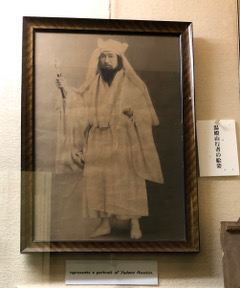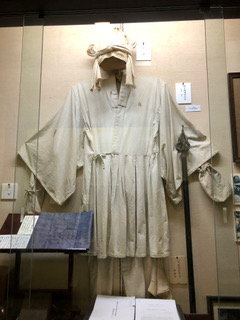Japanese Mummies
- At June 02, 2021
- By admin
- In Annes Letters
 0
0
Dear Family and Friends,
Did you know that Japan has mummies? I didn’t until very recently. Of course, the history of this land extends back tens of thousands of years. But unlike Egyptian mummies, these Japanese preserved beings are relatively recent. In fact, the last one occurred in the 19th century, the first about 800 years ago in the Heian Era.
Besides age, another way the two differ is that in Egypt the pharaoh was mummified after death, probably as a way to preserve the god that he represented, or even the splendor and ego of the man himself. He was also laid to rest in a coffin.
In Japan, however, the mummies were monks of the Shingon Buddhist sect. They chose to become mummies while they were living. These men were very devoted believers and became mountain ascetics, living many years in isolation and prayer as a way to purify themselves.


After several years of this, each in his own way realized he wanted to give his physical life to help alleviate the suffering of humanity. So, they started the long ordeal to become a mummy. First, they reduced their physical selves as much as possible. They ate only nuts from the mountain and buckwheat mash, and drank only water. Venerable Chukai did this for eight years, Venerable Emmyokai for five. In some cases, the monk would also drink mild doses of lacquer. This, of course, encouraged their death, but would also preserve their body, which the monks wanted to do.
When these brave souls realized they were close to dying, they had devotees dig a narrow hole about three meters deep and lined with stones. They would sit in a lotus position and be lowered into this “tomb”. Then the top would be sealed off. But a small opening was left with a bamboo pole protruding through the surface.

Did you know that Japan has mummies? I didn’t until very recently. Of course, the history of this land extends back tens of thousands of years. But unlike Egyptian mummies, these Japanese preserved beings are relatively recent. In fact, the last one occurred in the 19th century, the first about 800 years ago in the Heian Era.
Besides age, another way the two differ is that in Egypt the pharaoh was mummified after death, probably as a way to preserve the god that he represented, or even the splendor and ego of the man himself. He was also laid to rest in a coffin.
In Japan, however, the mummies were monks of the Shingon Buddhist sect. They chose to become mummies while they were living. These men were very devoted believers and became mountain ascetics, living many years in isolation and prayer as a way to purify themselves.

As Buddhists, they believed that all life is suffering and transitory. They also wanted to relieve the suffering of others. They felt offering their very lives so others might suffer less would be the greatest service they could give. Likewise, they believed their intention and purpose would live after them. They also strongly believed that after their death, they would become fully their Buddha nature. That meant their power to assist others would become very great. So, if devotees prayed to them, the mummified Buddha monk would come to their aid and answer their prayers.
There are sixteen self-mummified monks, or soku-shin-butsu, in Japan. Eight of them are in the Tohoku region, in Yamagata Prefecture. I recently visited a temple in Sakata City that has two of them: the Venerable Chukai and the Venerable Emmyokai. Their stories are truly astonishing and very thought-provoking. At different times, these two had been abbots of the Kaikoji Temple. But at age 50, both of them knew they wanted a more rigorous involvement with their Buddhist practices. So, they went to Mount Yudono, one of the three most sacred mountains in Yamagata. There they would live very austere, isolated lives dedicated to prayer and meditation.
There are sixteen self-mummified monks, or soku-shin-butsu, in Japan. Eight of them are in the Tohoku region, in Yamagata Prefecture. I recently visited a temple in Sakata City that has two of them: the Venerable Chukai and the Venerable Emmyokai. Their stories are truly astonishing and very thought-provoking. At different times, these two had been abbots of the Kaikoji Temple. But at age 50, both of them knew they wanted a more rigorous involvement with their Buddhist practices. So, they went to Mount Yudono, one of the three most sacred mountains in Yamagata. There they would live very austere, isolated lives dedicated to prayer and meditation.

After several years of this, each in his own way realized he wanted to give his physical life to help alleviate the suffering of humanity. So, they started the long ordeal to become a mummy. First, they reduced their physical selves as much as possible. They ate only nuts from the mountain and buckwheat mash, and drank only water. Venerable Chukai did this for eight years, Venerable Emmyokai for five. In some cases, the monk would also drink mild doses of lacquer. This, of course, encouraged their death, but would also preserve their body, which the monks wanted to do.
When these brave souls realized they were close to dying, they had devotees dig a narrow hole about three meters deep and lined with stones. They would sit in a lotus position and be lowered into this “tomb”. Then the top would be sealed off. But a small opening was left with a bamboo pole protruding through the surface.

The monk would chant prayers and ring a bell. When people could no longer hear that, they knew the monk had died. They would open the “tomb” to be sure, remove the bamboo pole, then seal it again for 1000 days. After that the monk would have become a mummy and a Buddha. He would then be placed in a temple where devotees could pray to him.

I spoke to several locals about soku-shin-butsu. Every time they would become silent, bow their heads, and place their hands in prayer. “They were such selfless people,” they would say. “I ask them for help when I need it most. I always feel assured my prayers are answered.”
And sure enough, when I was ushered into the temple and stood before these Buddha-mummies, I felt a sense of the deep devotion of the thousands of believers who had been there before me and those who would come after. I also deeply pondered the ordeal those men had endured in order to perform the greatest sacrifice they could offer: their lives. And like them, I hope their choice will enable our troubled world, and individuals in it, to find hope, inner guidance, and stability, so we, in turn, can serve others in our own particular ways.
Love,
Anne

I spoke to several locals about soku-shin-butsu. Every time they would become silent, bow their heads, and place their hands in prayer. “They were such selfless people,” they would say. “I ask them for help when I need it most. I always feel assured my prayers are answered.”
And sure enough, when I was ushered into the temple and stood before these Buddha-mummies, I felt a sense of the deep devotion of the thousands of believers who had been there before me and those who would come after. I also deeply pondered the ordeal those men had endured in order to perform the greatest sacrifice they could offer: their lives. And like them, I hope their choice will enable our troubled world, and individuals in it, to find hope, inner guidance, and stability, so we, in turn, can serve others in our own particular ways.
Love,
Anne
PS. I was not allowed to take photos of the mummies directly. So, the illustrations in this essay are photos I took from the brochure of Kaikoji Temple



